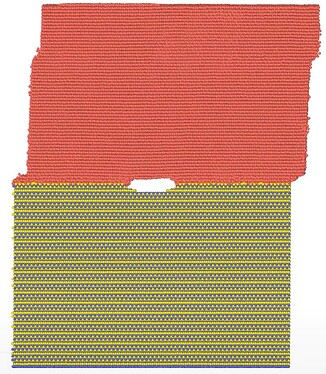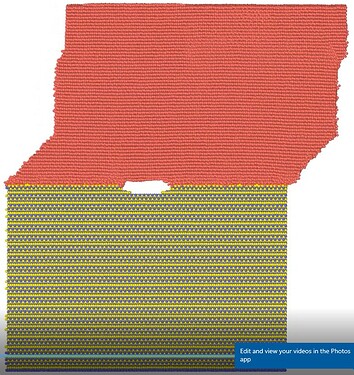Dear friends,
I am experiencing an issue with the mode II fracture test scenario at the SiC-Al interface. In my simulation, I utilized the Tersorff potential for SiC, an eam/alloy potential for Al atoms, and a Morse potential for interactions between Al-Si and Al-C atoms. To manipulate the model, I employed a velocity command to move the upper and lower boundaries. As evident from the accompanying video, the crack fails to propagate and instead exhibits sliding behavior on the aluminum surfaces far from the crack.
I would greatly appreciate your guidance in resolving the issue I am currently facing. Here is some important parts of my script:
#-------------------------- Potentials -----------------------------------
pair_style hybrid tersoff eam/alloy morse 3.5 morse 3.5
pair_coeff * * tersoff 2005_SiC_II.tersoff NULL Si C
pair_coeff * * eam/alloy Al99.eam.alloy Al NULL NULL
pair_coeff 1 2 morse 1 0.4824 1.322 2.92
pair_coeff 1 3 morse 2 0.4691 1.738 2.246
#-------------------------- minimization by cg algorithm ----------------
compute new2d mobile temp/partial 1 1 0
thermo 400
thermo_style custom step lx ly lz
min_style cg
minimize 1e-10 1e-10 10000 10000
velocity mobile create 300 12345 mom yes rot yes dist gaussian
fix 1 all nve
fix 2 mobile temp/rescale 100 300 300 10 1.0
fix_modify 2 temp new2d
thermos 1000
thermo_style custom step temp lx ly lz press pxx pyy pzz pe
thermo_modify temp new2d
run 30000
#**************************fix boundary
velocity boun set 0.0 0.0 0.0
fix fixboun boun setforce 0.0 0.0 0.0
#--------------------------- Deformation -------------------------
reset_timestep 0
variable p5 equal “-pxz/10000”
thermo_modify temp new2d
velocity boun_SiC set 0.003 0.0 0.0
velocity boun_Al set -0.003 0.0 0.0
velocity mobile ramp vx 0 0.003 z 10 260 sum yes
neigh_modify once yes
run 1000000

